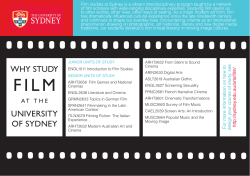
Cinemetrics Program - Film Studies Center
CINEMETRICS ACROSS BORDERS APR 30-MAY 3, 2015 University of Chicago Presented by Cinemetrics Across Boundaries: A Collaborative Study of Montage, a project of the Neubauer Collegium for Culture and Society. Co-sponsored by the Film Studies Center, the Franke Institute for the Humanities and the Chuck Roven Fund for Cinema and Media Studies. THURSDAY, APRIL 30 Afternoon session held at the Neubauer Collegium 5701 South Woodlawn Avenue 2:45 p.m.-3:00 p.m. Registration Welcoming Remarks Jonathan Lear Roman Family Director, Neubauer Collegium for Culture and Society, University of Chicago 3:00 p.m.-3:30 p.m. Opening Remarks Yuri Tsivian (Faculty Director, Cinemetrics Across Boundaries: A Collaborative Study of Montage, University of Chicago) Screening: Boyhood (2014) Directed by Richard Linklater, editing by Sandra Adair 3:30 p.m.-6:30 p.m. 6:30 p.m. Reception FRIDAY, MAY 1 May 1-3 sessions held at the Reva and David Logan Center for the Arts 915 East 60th Street, Room 201 9:30 a.m.-10:00 a.m. Keynote Address Coffee Cutting Boyhood Sandra Adair, A. C. E. 10:00 a.m.-11:15 a.m. 11:30 a.m.-1:00 p.m. Panel One Latest Trends Barry Salt (London Film School) Methods of Time-series Analysis of the Shot Structure of Hollywood Film Jordan DeLong (Indiana University Bloomington) 1:00 p.m.-2:15 p.m. Lunch 2:15 p.m.-3:45 p.m. Panel Two On the Heterogeneity of Cinematography in the Films of Aki Kaurismäki Jaakko Seppala (Helsinki University) Red Herrings and the Drama Factor: Cinemetrics and Reality Television Christina Peterson (Eckerd College) 4:00 p.m.-6:30 p.m. Panel Three Computational Touch: Patterns of Expectations in Perception of Cinemetrical Graph Mohsen Nasrin (Carleton University) Information Density and Valid Evidence: Teaching with Cinemetrics Burke Hilsabeck (Oberlin College) 7:00 p.m. Dinner for participants SATURDAY, MAY 2 9:30 a.m.-10:00 a.m. Coffee Keynote Address How Movies Grab Our Attention James Cutting (Cornell University) 10:00 a.m.-11:15 a.m. 11:30 a.m.-1:00 p.m. Panel Four Small Data: A Report from the EASTT Group Kaitlin Fyfe and Lea Jacobs (University of Wisconsin, Madison) A Day in the Life of a Digital Humanist: Film Data, Tools and the Human Mind Adelheid Heftberger (Austrian Film Museum) 1:00 p.m.-2:15 p.m. Lunch 2:15 p.m.-3:45 p.m. Panel Five New Measurement Tool and Possible Improvements in Measuring and Representation of Data Gunars Civjans (Social Integration Agency, Latvia) Is Raw Data an Oxymoron? Or, the State of the Cinemetrics Database as a Digital Humanities Tool Ian Bryce Jones (University of Chicago) 4:00 p.m.-6:00 p.m. Panel Six The Future of 1913 Daria Khitrova (Harvard University) and Michael Baxter (Emeritus, Nottingham Trent University; 2013-14 Neubauer Collegium Visiting Fellow) Cinemetrics Looks at Griffith; Griffith Looks at Cinemetrics Yuri Tsivian (University of Chicago) and Michael Baxter (Emeritus, Nottingham Trent University; 2013-14 Neubauer Collegium Visiting Fellow) 7:00 p.m. Dinner for participants SUNDAY, MAY 3 9:30-10:00 a.m. Coffee Keynote Address Cinemetrics and Sound Cinema: A Field Report Charles O’Brien (Carleton University) 10:00 a.m.-11:15 a.m. Round Table Discussion and Concluding Remarks 11:45 a.m.-1:00 p.m. Learn more about the Neubauer Collegium project Cinemetrics Across Boundaries: A Collaborative Study of Montage at: neubauercollegium.uchicago.edu/faculty/cinemetrics/ KEYNOTE SPEAKERS Sandra Adair, A. C. E. Cutting Boyhood Sandra Adair, A.C.E. is an award winning feature film editor who resides in Austin, Texas. Adair has enjoyed an ongoing artistic collaboration with film director Richard Linklater, having edited 18 films for him over the past 22 years, some of which include the cult classic Dazed and Confused, the 2012 comedy Bernie and the critically acclaimed “Before” trilogy, Before Sunrise, Before Sunset and Before Midnight. In 2014, Linklater’s Boyhood premiered at the Sundance Film Festival to rave reviews and has since won numerous awards, including 3 Golden Globes including Best Picture, Drama, and 3 BAFTAs. Boyhood also earned 6 Academy Award nominations, including Best Editing for Sandra Adair. Adair also won the American Cinema Editor’s Eddie Award for Best Editing, Drama, for Boyhood in 2015. Adair is currently editing Linklater’s That’s What I’m Talking About. Adair was nominated for an Eddie Award for Best Editing of a Musical or Comedy by the American Cinema Editors in 2003 for School of Rock, and won the Best Edited Documentary at the Woodstock Film Festival in 2012 for the feature doc Shepard and Dark, for director Treva Wurmfeld. Some of Adair’s other credits with other directors include Everything Must Go, starring Will Ferrell, and the award winning documentary Sushi: The Global Catch. She is a member of the Academy of Motion Picture Arts and Sciences and American Cinema Editors and enjoys to supporting and mentoring new filmmakers in the Austin area. James E. Cutting (Cornell University) How Movies Grab Our Attention James E. Cutting is professor of psychology at Cornell University, where he has taught since 1980. Before Cornell, he taught at Wesleyan and Yale Universities. He was a Fellow of several divisions of the American Psychological Association, including the division of Psychology and the Arts; and is a Charter Fellow of the American Psychological Society, and a member of the College Art Association and the Society for the Cognitive Studies of the Moving Image. He has two published books and over a hundred scientific articles. He was editor of Psychological Science (2003-2006), has served as editor of the Journal of Experimental Psychology: Human Perception and Performance (1989-1993), and as associate or consulting editor for several others. In 1993 he was awarded a John Simon Guggenheim Fellowship. With it he studied the representation of depth and of space in the art of Paris and surrounding cities in Europe. For three decades he was actively engaged in research on various aspects of visual perception, exploring the nature of the information used, particularly as it is arrayed in natural motions such as those of, and seen by, a pedestrian walking through a cluttered environment. Since much of his research is focused on everyday perception, since this research uses computer graphics, and since the computer images are irrevocably pictures, he became deeply interested in the relation between pictures (as two dimensional objects) and the three-dimensional natural world. His academic interest turned to cinema as a tool to understand the constraints under which the human visual system evolved. He argues that the vast cultural significance of cinema, and its considerably different structure from what is seen during, say, a stroll through the real world provides insights into the underpinnings of our visual perception. Since we did not evolve to look at cinema, and since it arguably “evolved” to fit what we can digest easily, its structure can suggest what our visual systems did, and did not, evolve to see. Charles O’Brien (Carleton University) Cinemetrics and Sound Cinema: A Field Report Charles O’Brien is an associate professor of Film Studies at Carleton University. He is the author of Cinema’s Conversion to Sound: Technology and Film Style in France and the United States (Indiana U. Press, 2005), as well as articles and book chapters on various topics, including: staging and lighting in D. W. Griffith’s Biograph films; voice-dubbing practices; French and German film versions of Weill-Brecht’s Die Dreigroschenoper; the statistical analysis of film style; digital restorations of early film colour; film noir’s beginnings in 1930s France; Susan Sontag’s film criticism; the reception of Hollywood musicals in 1930s France; French films of the German occupation; film and electrification in Europe and North America prior to WWI; and films set in the French colonies. O’Brien has received awards and fellowships including: a Chateaubriand Fellowship; a residential fellowship at the Camargo Foundation in Cassis, France; and four research grants from Canada’s Social Sciences and Humanities Research Council. In 2006 O’Brien was appointed Ailsa Mellon Bruce Senior Fellow at the Center for Advanced Study in the Visual Arts, at the Washington D.C. National Gallery of Art. O’Brien is now completing a book, Movies, Songs, and Electric Sound, which draws on a filmography comprised of 500 films made in Britain, France, Germany and the U.S. during 1927-1934. WHAT CINEMETRICS DOES AND WHY IT BRINGS US HERE It takes skills to tell a story. What skills it takes depends on the medium we use. Film is the medium of showing. What to show closer? What to show longer? What to show once, and what to show again? Filmmakers have dealt with these questions since the beginning of cinema, and grapple with them still. We who study film history today need to have a clear picture of how and why filmmakers made these decisions throughout time. What were D.W. Griffith’s favorite camera setups in 1914? In what year did Chaplin learn to cut? Questions like these relate to film editing, and will keep coming up as long as film editing remains art. How many cuts are hidden within the seemingly seamless films like Rope or Birdman? How did they slice and splice the 12 years of real-time life in Boyhood? Cinemetrics helps to puzzle out such questions. Gunars Civjans and I launched the website in 2005. In the ten years since, Cinemetrics has grown into a global forum on quantitative and experimental methods in film studies. Hundreds of film students and scholars from different countries, each with his or her own research agenda, submit their shot-length and shot-scale data to the Cinemetrics website, and more visit Cinemetrics daily to use data collected by others to further their own investigations. Barry Salt to whom our field owes the idea of Average Shot Lengths has made available via Cinemetrics data from more than 10,000 films. For years, we who come here today have been comrades-in-arms in cyberspace. Now, the Neubauer Collegium for Culture and Society has enabled us to meet in person and talk to each other face to face, in real space. Welcome to Chicago! Yuri Tsivian Neubauer Collegium Faculty Director, Cinemetrics Across Boundaries: A Collaborative Study of Montage neubauercollegium.uchicago.edu UChiCollegium 5701 South Woodlawn Avenue Chicago IL 60637 773.702.6030
© Copyright 2025










